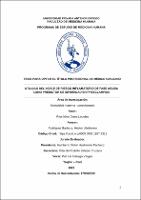Utilidad del índice de riesgo inflamatorio de fase aguda como predictor de severidad en preeclampsia

View/
Download
(application/pdf: 835.5Kb)
(application/pdf: 835.5Kb)
Date
2023Author(s)
Ríos Mino, Diana Lourdes
Metadata
Show full item recordAbstract
Determinar la utilidad del índice de riesgo inflamatorio de
fase aguda como factor predictor de severidad en preeclampsia.
Materiales y Métodos: Se realizó un estudio observacional analítico,
de pruebas diagnósticas, en el que se incluyeron a 152 gestantes en
el tercer trimestre de gestación atendidas por el servicio de Gineco –
Obstetricia del Hospital Belén de Trujillo, divididas en dos grupos: 76
gestantes con diagnóstico de preeclampsia con criterios de severidad
y 76 gestante con diagnóstico de preeclampsia sin criterios de
severidad. En dichos grupos se evaluaron los siguientes parámetros:
índice neutrófilos/linfocitos (INL), índice plaquetas/linfocitos (IPL),
hemoconcentración, índice hematocrito/albúmina (IHA), el volumen
plaquetario medio (VPM), la amplitud de distribución eritrocitaria
(ADE) y el índice de riesgo inflamatorio de fase aguda. Para evaluar
los puntos de corte de los parámetros estudiados, se empleó la curva
ROC y mediante la prueba Chi Cuadrado, se determinó la
sensibilidad, especificidad, VPN y VPP para cada uno de los índices.
Resultados: De las 152 pacientes, 76 tuvieron diagnóstico de
preeclampsia sin criterios de severidad y 76 con criterios de
severidad. Dentro de las características laboratoriales el índice
neutrófilo linfocito (INL), índice plaquetas linfocito (IPL),
hemoconcentración, volumen plaquetario medio (VPM) y amplitud de
distribución eritrocitaria (ADE), por sí solos, no tuvieron significancia
estadística. Sin embargo, el índice hematocrito albúmina >12 por sí
solo, si obtuvo significancia estadística (p=0.001). Así mismo el
índice de riesgo inflamatorio como predictor de severidad, sí se
asoció a severidad en preeclampsia. A través de las curvas ROC, se
encontró que el mejor punto de corte fue de 2.5, sensibilidad 68.4%,
especificidad 50.0%, valor predictivo positivo 57.8% y valor predictivo
negativo 61.3%.
Conclusión: El índice de Riesgo Inflamatorio de Fase Agua debería
ser considerado como un factor útil para la predicción de severidad
en preeclampsia. To determine the usefulness of the acute phase
inflammatory risk index as a predictor of severity in preeclampsia.
Materials and Method: An analytical observational study of
diagnostic tests was carried out, in which 152 pregnant women in the
third trimester of pregnancy attended by the Gynecology-Obstetrics
service of the Hospital Belén de Trujillo were included, divided into
two groups: 76 pregnant women diagnosed with preeclampsia with
severity criteria and 76 pregnant women diagnosed with
preeclampsia without severity criteria. In these groups, the following
parameters were evaluated: neutrophil/lymphocyte ratio,
platelet/lymphocyte ratio, hemoconcentration, hematocrit/albumin
ratio, mean platelet volume, erythrocyte distribution width, and acute
phase inflammatory risk index. To evaluate the cut-off points of the
studied parameters, the ROC curve was used and by means of the
Chi Square test, the sensitivity, specificity, NPV and PPV were
determined for each of the indices
Results: Of the 152 patients, 76 were diagnosed with preeclampsia
without severity criteria and 76 with severity criteria. Among the
laboratory characteristics, the neutrophil-lymphocyte index (INL),
platelet-lymphocyte index (IPL), hemoconcentration, mean platelet
volume (MPV) and erythrocyte distribution width (ADE), by
themselves, did not have statistical significance. However, the
albumin hematocrit index >12 by itself did obtain statistical
significance (p=0.001). Likewise, the inflammatory risk index as a
predictor of severity was associated with severity in preeclampsia.
Through the ROC curves, it was found that the best cut-off point
was 2.5, sensitivity 68.4%, specificity 50.0%, positive predictive
value 57.8% and negative predictive value 61.3%.
Conclusions: The Acute Phase Inflammatory Risk Index should be
considered as a useful factor for predicting severity in preeclampsia
Collections
- Medicina Humana [2969]

